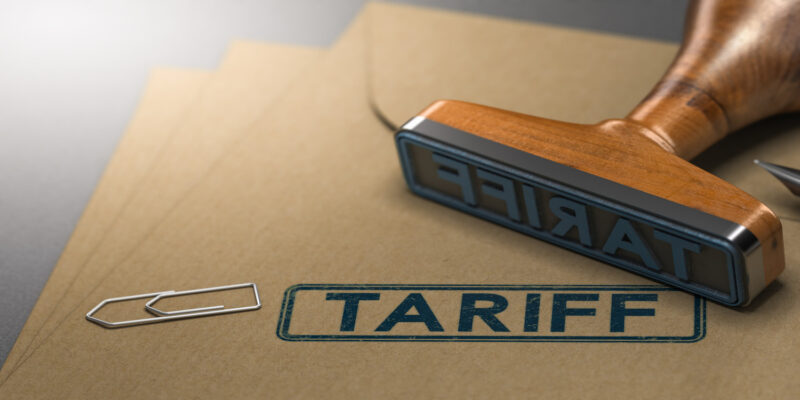CDMOs/CMOs & Tariffs: The Next Move
The White House extended the deadline to impose reciprocal tariffs on most countries until August 1st. What is the impact on manufacturing & supply lines, and what may be next?
By Patricia Van Arnum, Editorial Director, DCAT, pvanarnum@dcat.org
On again; off again
The evolving tariff scheme in the US took another turn this week (week of July 7, 2025) with an extension of the deadline for reciprocal tariffs on US trading partners, the imposition of tariffs ranging from 25% to 40% on 14 countries, a late announcement on Thursday July 10th by the US government of a possible 35% tariff on Canadian imports, and the looming threat of pharmaceutical-industry-specific tariffs.
As with other industries, the bio/pharmaceutical industry is waiting to see how US trade policy will evolve in the form of tariffs—both overall tariffs and potentially industry-specific tariffs. July 9, 2025 was the deadline for the implementation of reciprocal tariffs by the US with its trading partners. The Trump Administration first laid out a plan for imposing reciprocal tariffs in February (February 2025) to counter non-reciprocal trading arrangements with its trading partners and to improve US competitiveness, including in manufacturing. Those reciprocal taxes were scheduled to go into effect on April 9, 2025, but the Administration placed a 90-day pause (until July 9, 2025) on their implementation to enable countries to negotiate these tariffs with the US government. The US government has now extended the deadline once again, this time to August 1, 2025, except for 14 countries, which were sent letters from the White House to specify tariffs ranging from 25% to 40%.
The Budget Lab at Yale University summarized all tariff actions taken through July 10, 2025 (see Table I at end of article), including country-specific tariffs to take effect August 1, 2025, on Japan, South Korea, South Africa, and emerging countries. On a country-by-company basis, this breaks down as follows: Japan, South Korea, Malaysia, Kazakhstan, Tunisia (25%); South Africa, Bosnia (30%); Indonesia (32%), Bangladesh, Serbia (35%); Cambodia, Thailand (36%); and Laos and Myanmar (40%). Separately, a US-Vietnam framework was announced, which consists of a 20% broad tariff and a 40% tariff on goods transshipped from China. In addition, late on Thursday July 10, 2025, the US floated a possible 35% tariff on Canadian imports, effective August 1, 2025, following a breakdown in trade talks between the US and Canada.
New countries and pharma in the crosshairs
In terms of the pharma industry, the earlier proposed tariffs on the European Union and Switzerland were most problematic for the supply of ingredients and pharmaceuticals for innovator products and the tariffs imposed on India and China for ingredients and pharma products for generics. Now, Japan and South Korea will be subject to a 25% tariff and South Africa 30%, effective August 1, 2025.
The imposition of further country-specific tariffs would be in addition to pharmaceutical industry-specific tariffs if they go into effect. In comments this week, President Donald J. Trump said that pharmaceutical-industry-specific tariffs could be up to 200% and may be imposed in 12 to 18 months. These tariffs would be the outgrowth of an investigation that was initiated under Section 232 of the Trade Expansion Act of 1962, as amended, which allows the President to impose import restrictions based on an investigation and affirmative determination by the US Department of Commerce that certain imports threaten to impair US national security. In general, a Section 232 investigation considers the following (1) existing domestic production of the product; (2) future capacity needs; (3) manpower, raw materials, production equipment, facilities, and other supplies needed to meet projected national defense requirements; (4) growth requirements, including the investment, exploration, and development to meet them; and (5) any other relevant factors.
Companies react
Celltrion, an Incheon, South Korea-based producer of biosimilars, issued a letter to its shareholders on July 9, 2025, on its short-, mid-, and long-term response plans, including further partnering with CMOs, stockpiling, and potential acquisition of US-based manufacturing capacity
“On July 9, 2025 (Korea Standard Time), US President Donald Trump stated that his [A]administration is considering imposing tariffs on pharmaceuticals, with a grace period of up to 18 months,” said Celltrion in a letter to its shareholders. “Our company has been continuously monitoring developments regarding the potential imposition of US pharmaceutical tariffs and has prepared response strategies for various scenarios to minimize potential impact.”
The company laid out its response strategy–both short and long term. On a short-term basis, it says that it has already secured a two-year inventory supply and plans to maintain this two-year inventory on a rolling basis going forward. Mid-term, it has finalized contracts with local CMO partners to enable local production of products sold in the US.
In the long-term, Celltrion said that it is “currently reviewing the acquisition of a company with manufacturing facilities in the US and we will promptly provide further details to our shareholders once the matter becomes more concrete…Regardless of when or to what extent the US pharmaceutical tariff policy is finalized, our goal is to have all necessary preparations in place by the end of next year to ensure minimal impact on our business.”
| Current US Tariff Policy as of July 9, 2025 (All dates specified are in 2025) | |
| US Tariffs**** | Retaliatory Tariffs |
| China: 20% broad tariff on all Chinese imports (effective February 4; increased March 4) | China 10%/15% list (announced February 4) |
| Canada: 10% tariff on Canadian potash and energy (effective April 2) | Canada 25% list (announced March 4) |
| Canada & Mexico: 25% tariff on all Mexican imports and other Canadian imports* (effective March 4) | China 10%/15% list (announced March 4) |
| Automobilies: 25% tariff on all automobiles, with an exemption for US content and a discount through April 2027 on parts tariffs for US-assembled autos** (effective April 3), reduced to 10% on the first 100,000 UK imports (announced May 8) | Canada 25% list; (announced March 13) |
| Steel and aluminum imports: 50% tariff on all steel and aluminum imports (effective March 12, raised May 30), 0% on the UK (announced May 8), extended to steel derivative products (effective June 23) | China broad 125%, lowered to 0% for 90 days (announced April 4; increased April 11; lowered May 12) |
| Minimum tariffs (modified April 2 announcement): 10% minimum tariffs on all countries ex. China, Canada, & Mexico; 125% tariff on China lowered to 10% for 90 days on May 12 (effective April 9, modified April 9, 90-day duration)*** Country-specific tariffs. July 7 announcement: Japan, South Korea, Malaysia, Kazakhstan, Tunisia (25%), South Africa, Bosnia (30%), Indonesia (32%), Bangladesh, Serbia (35%), Cambodia, Thailand (36%), Laos, and Myanmar (40%) (effective August 1). | UK reduction in ethanol tariff on the US to 0% (announced May 8). |
| Vietnam: US-Vietnam July 2 framework: 20% broad tariff, 40% tariff on goods transshipped from China. | None as of July 9, 2025 |
** TBL assumes that 40% of automobile content in imported motor vehicles from Canada and Mexico are of US origin. For the purposes of the auto tariff rebate, TBL assumes that 1/3 of imported autos are assembled in the US.
*** The tariffs announced on April 2 apply to most imported goods but exempt steel, aluminum, and autos—which have already been tariffed separately in 2025—as well as copper, pharmaceuticals, semiconductors, lumber, energy, and critical minerals. The Administration clarified the scope of the semiconductor exemption on April 13. The Budget Lab at Yale University carved out these commodities in its analysis of the April 2 announcement but does stack tariffs on those commodities from earlier announcements where applicable.
**** Executive Order 14289 prevents many tariffs from stacking with one another and establishes the stacking order for tariffs, with the Section 232 automobile tariffs being the highest priority.
The Budget Lab, Yale University (July 10, 2025)






